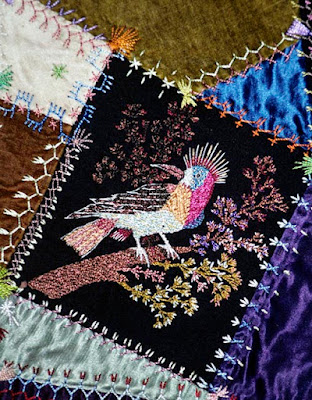When did the crazy quilt fad begin? We quilt historians dither.
But here is an early reference explaining the whole thing.
Early, 1881
Boston Globe, February 2, 1881
"I am making the loveliest Japanese silk quilt..." Amelia
The columnist compares the "Japanese" quilt to the hexagon rosette,
"hundreds of tiny pieces cut with great exactness, laid smoothly together 'over and over.' "
Old-fashioned silk style combined with the new.
From Laura Fisher's estate
I've found other references to "crazy quilt" or "Japanese quilt" later in the year 1881 but the February description to a Japanese quilt may be the earliest. The terms seem interchangeable.
Dated 1887, Isabella M. Smith, Dayton, Kentucky
West Virginia Project & the Quilt Index
I've been dating these as about 1882 at the earliest but I am going to have to move my estimate back a year. Crazy quilts date to 1881. Didn't find any references to either term in 1880.
Here's a reference to "Crazy work" in a quilt dated 1885
A 1904 "Slumbering Robe"
W. E. Prosser
Isabelle Ossing, West Virginia Project,
but made in Columbus, Ohio






.jpg)





.jpg)





Wonderful post! Thank you!
ReplyDeleteThese crazy quilts always amaze me! Does "Japanese" come from the panels? Or a particular style of placement?
ReplyDeleteFrom a Japanese design style, pattern with a crazed or fractured look.
DeleteAny "Japanese quilt" made in the 1880s was not likely made in Japan. Back when quilting first became popular, most were copies of traditional American quilts. My Japanese quilting friends were all women who had lived for a time in the states. In those days everyone slept on a "futon" on the floor, which was picked up and put away in a cupboard during the day. A quilt was not for a bed cover, but to display on a wall. The fabric to make kimono and obis was woven in a certain width and the construction of a kimono did not produce scraps. Fabrics used in quilts were probably from old used kimono. With the years, wearing of kimono has become less common, and many do not even know how to dress in one without help. Old kimono have taken on more use in quilts.
ReplyDeleteI should have said these are what Americans called Japanese quilts based on the crazed designed in Japanese porcelains. A cultural leap from ceramic design to quilt design.
DeleteThere is an earlier reference for that article from the Jan 8, 1881 Rural New Yorker, written by Mary Wager-Fisher called CONCERNING SCRAPS OF SILK AND VELVET. - HOW TO UTILIZE THEM.
ReplyDeleteMARY WAGER-FISHER.
"I WANT you to send me pieces-mere scraps will do--of your silk frocks. I am making lovliest Japanese silk quilt that ever you saw," wrote Amelia to me a little less than a year ago. I sent her the "Scraps" and ridiculed her for her folly in "piecing” a silk quilt. It seemed such endless business as I thought of the numerous silk quilts I had begun, hardly ever one finished with hundreds of tiny pieces cut with great exactness laid smoothly together “over and over.” Assuredly, any woman who valued her time must be a fanatic to undertake a task like that. ...
There are follow-ups on Feb 5, 1881 and Feb 19, 1881.
Feb 19: In reading Mary Wager Fisher’s communication in RURAL of Jan. 8th, concerning the use of scraps of silk and velvet, I was much interested, as it seemed easy and sensible. After collecting and smoothing out my stock, I was puzzled to know how to begin, and seeing you answer inquires, I have written to ask if she would illustrate a black one of the many she has made, and truly oblige.
There is an image of a few stitches, plus a diagram of a block layout in that issue. Cheers, Louise
Also in 1881, from The Household (of the Detroit free press). A cyclopædia of practical hints for modern homes. Ed. by May Perrin Goff - the Patchwork Section ... A very pretty way to utilize scraps, odds and ends of silk, is to make them into blocks for a "crazy quilt." All that is necessary for this is to cut square pieces of dark calico and baste the pieces on them as they happen to come — in any device or shape, having every block different, as it surely will be if they are pieced in the same shape as when given to the quilt-maker. Tiny pieces, only inch-square strips, triangles, anything and everything can be utilized. Silk and velvet are the prettiest, and in this day of bright ribbons quite easy to get. On the plain piece in each block may be worked an emblem, embroidered or painted, or all three may be used on one square. The small Japanese handkerchiefs give odd designs ; one that can very easily be copied is a spider web, and caught in the meshes the innocent fly, with the hungry spider dropping down by one of its long, almost invisible threads, ready to pounce upon it. Another, a mallet crossed with croquet balls lying near ; a bow and arrows, and target with the arrows piercing it ; a rake and hoe with handles crossed ; the ever-present horseshoe with whip near it, if you please; the American flag with its stars and stripes, or initials and monograms. These quilts should be lined with bright-colored sateen and corded with heavy silk cord on the edge. ...
ReplyDeleteI was hoping you'd have earlier Louise.
ReplyDeleteWell in 1877 there were Crazy Cushions - on embroidery canvas. Mentions of this type of cushion continued into 1880. A new type of Crazy Cushion is mentioned at the end of 1880, using scraps of fur. Then scraps of Velvet and Silk are mentioned The Rural New Yorker in Jan 1881, to make a Japanese quilt. Cheers, Louise
ReplyDeleteLynchburg Daily Virginian Fri, Apr 20, 1860 ·Page 2 bottom of column 4 has an advertisement for Japanese Quilts.
ReplyDelete